1.3 - A practice of analysis in the tonal harmonic discourse from Bach to Wagner ||
A) FORMULAS - 1. Definition of
a formula ::
2. Presentation of
the little catalogue of harmonic vocabulary ::
3. User's guide to
the little catalogue and various instructions ::
4. Examples
illustrating the little catalogue (motifs: 1, 2, 3, 4, 5, 6a, 6b, 7, 8, 9, 10, 11, 12, 13, 14, 15, 16, 17, 18, 19, 20, motifs in combination)
B) SEQUENCES - 1. Definition of a
harmonic sequence :: 2. Classifying
sequences :: 3. Melodic
formulations: characteristic motifs :: 4. The tonal
nature of the harmonic sequence :: 5.The tripartite
structure of the harmonic sequence :: 6. A
modulating sequence or not? :: 7. Diversification
of harmonic content :: 8. The harmonic
sequence as a place of subversion :: 9. Conclusion
8. THE HARMONIC SEQUENCE AS A PLACE OF SUBVERSION

But
how far can a variant go? It seems that the abundant, if not
over-abundant, use of the harmonic sequence by the composers of tonal
music forced them to become ever more inventive in order to avoid
banality. And inventive they were, with definite audacity. Granted,
therein lies a paradox: how can recourse to such a fertile stereotype
in the tonal discourse lend itself to a reversal of order? The paradox
is merely apparent. It is precisely the strength of the structure,
shaped and recognized due to a long tradition, that allows composers
to make exceptions at many levels passable. For
example:
1. Six-four chords with a harmonic function
It is in the context of a sequence that a major or minor chord in
its second inversion (six-four) can claim a
veritable harmonic status (rather than the ornamental status normally attributed to it) with the most validity:
Example 447 : J. Haydn : Piano sonata, Hob. XVI:13, Menuet, Trio (mm 9-18)
Type 1 sequence with six-four chords

Example 448 : J. Brahms : Intermezzo, op. 75, no 7 (mm 17-21)
Type 1 sequence with six-four chords

Example 449 : F. Schubert : String quartet no 1, D. 18, III, Menuetto, Trio (mm 17-26)
Type 2 sequence with six-four chords
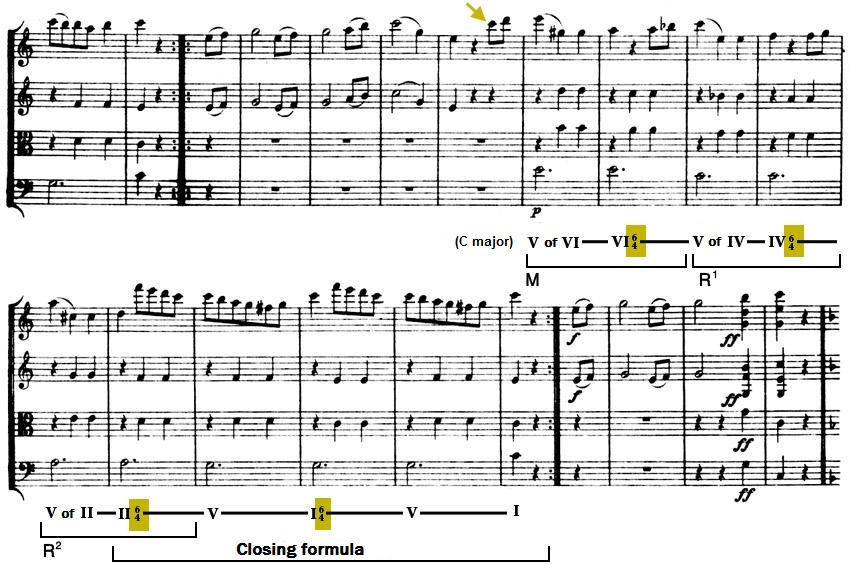
Example 450 : F. Chopin : Etude, op. 10, no 12 (mm 65-77)
Type 1 sequence with six-four chords

Example 451 : W.A. Mozart : Fantasy, K. 475 (mm 73-77)
Type 1 sequence with six-four chords
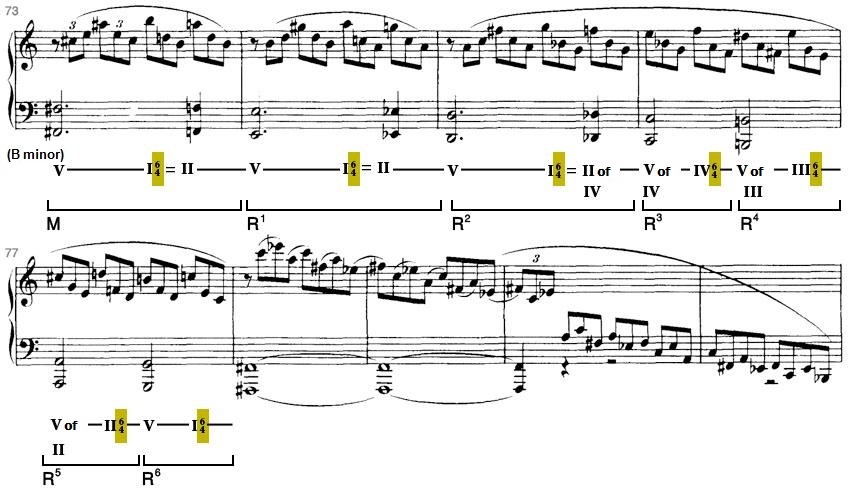
Example 452 : J. Brahms : Symphony no 1, op. 68, IV, Allegro non troppo ma con brio (mm 113-115)
Type 4 sequence with six-four chords

2. Chords altered by analogy (a.a.)
It
is within a sequence that altered chords may appear for no other reason
than to contribute to the perfection of symmetry (a phenomenon
identified by Goldman: p.218-219, 1965); occurring in a clearly
non-modulating context, these chords are otherwise inexplicable (in
terms of syntax). Examples 453 and 454 each illustrate a sequence which
is certainly non-modulating (considering the criteria cited earlier)
yet nevertheless perfectly symmetrical, both in terms of the chord
structures employed in the model and in terms of the interval of
progression; this is made possible due to the use of chords altered by
analogy.
Example 453 : F. Liszt : Venezia e Napoli (revised version), supplement to Les Années de Pélerinage, Italie, Tarentella (end)
Type 2 sequence
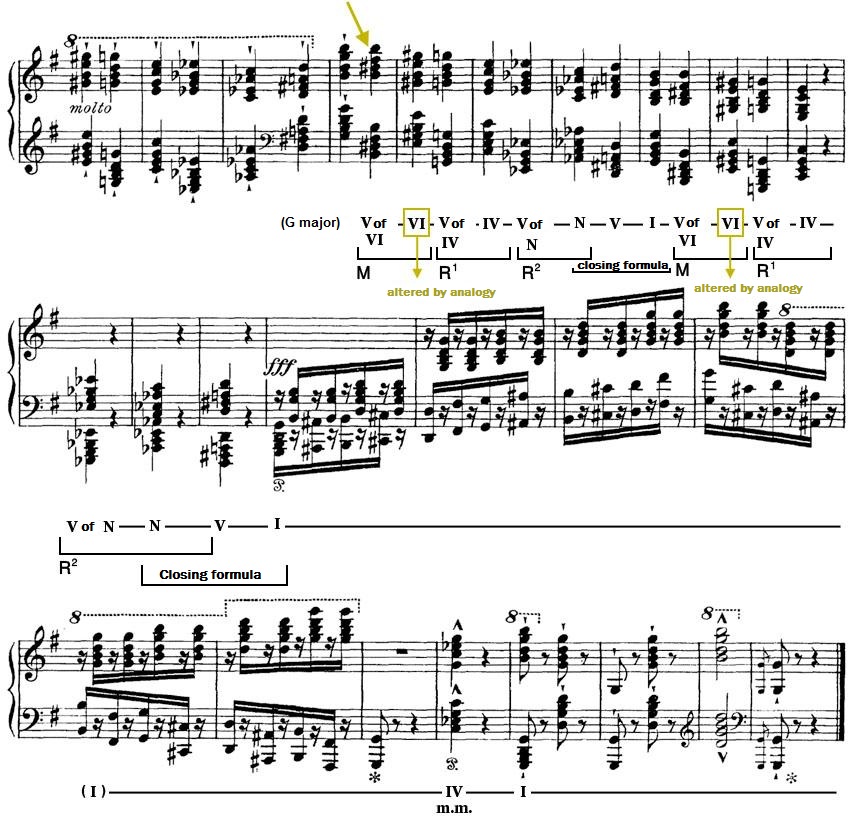

Example 454 : F. Liszt : Notturno, Liebestraum no 3 (mm 9-24)
Type 10 sequence
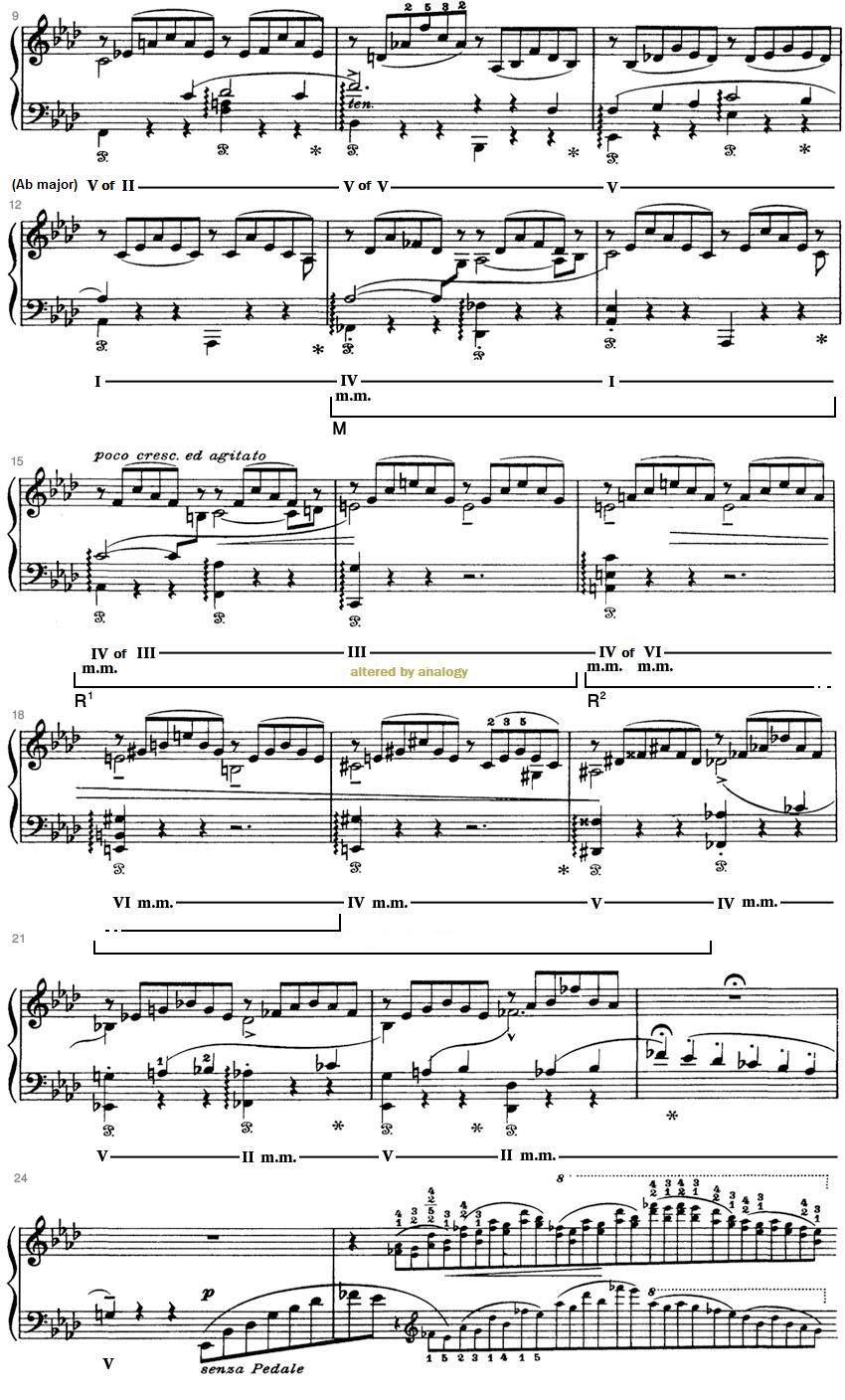
Example 455 demonstrates perfect symmetry with respect to the chord
structures used in the model, while the interval of progression oscillates
between a major and a minor second:
Example 455 : W.A. Mozart : Piano sonata, K. 280, I (mm 17-26)
Type 1 sequence
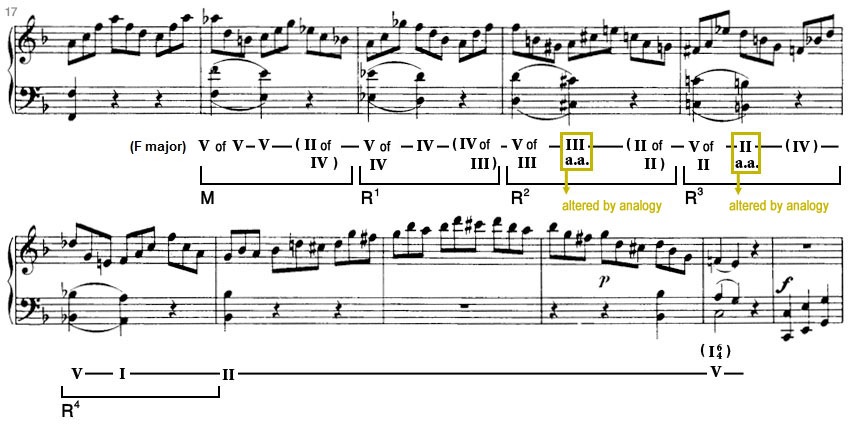
3. Chords drawn from the complete chromatic collection
In
an ascending or descending sequence that progresses chromatically by
step,
we may observe the use of chords foreign to the constitutive degrees of a
key forming
dominant-tonic pairs (either in the standard order or in retrograde).
In such cases, each and every one of the twelve degrees of a chromatic
scale is allowed to serve as the root of a major or minor chord acting as
either a principal tonic (in the case of the first scale degree) or as a
secondary
tonic (for all other degrees).
Figure 41

Figure 42

Example 456 : J.P. Rameau : Hippolyte et Aricie, Act II, Scene 4 (mm 712-722)
Type 3 sequence
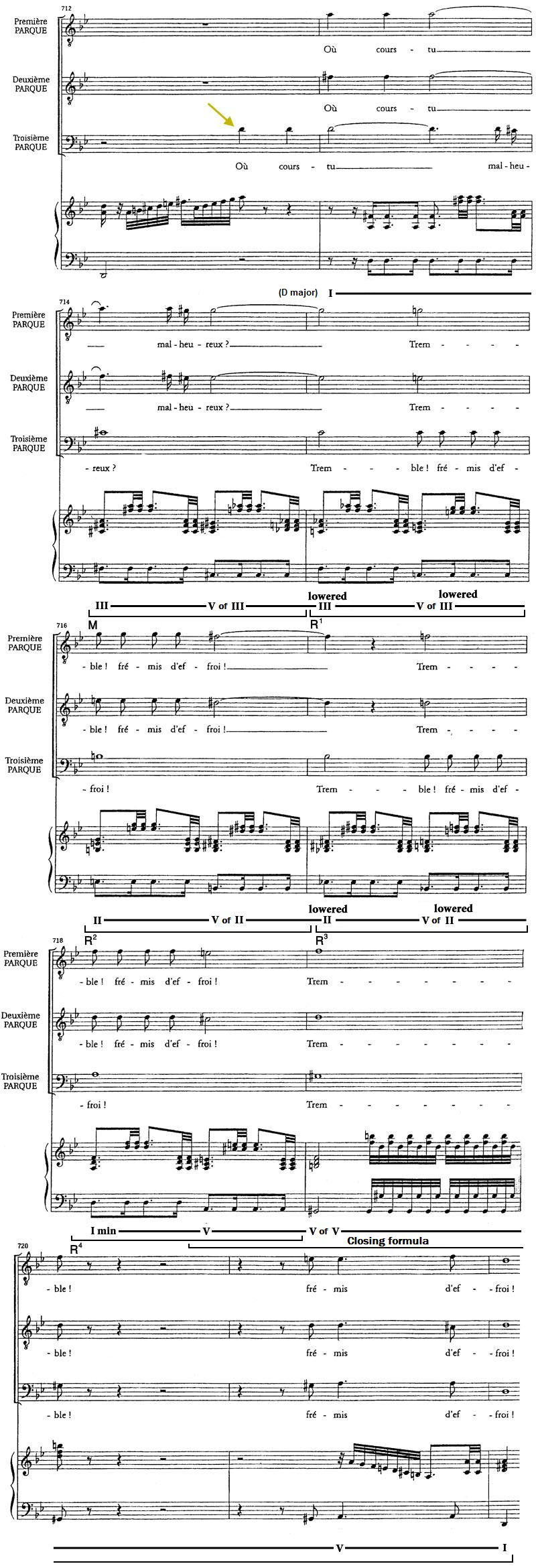
Example 457 : R. Wagner : Parsifal, Act I, Scene 2 (mm 1-10)
Type 7 sequence

4. Bizarre couples
It
is
within sequences that we most often encounter bizarre couples that have
every appearance and even acquire the same legitimacy as a
dominant-tonic pair, given an effort of interpretation:
First bizarre couple:
Figure 43

In
this first case, illustrated six different ways, the function V can be
explained through a reference to a complete or incomplete diminished
seventh
structure (B - D - F - Ab) built on the third (acting as an
anticipation) of I. It must be added that, in order to validate
its role, V9 on the third of I must be followed immediately by
I; only another formulation of V may separate the two (figure 43,
examples 5
and 6). In these last cases, depending on the voice leading, the
third of I may no longer act as an anticipation of I but rather as
an appoggiatura to the 5th degree, following the example of a minor
ninth.

Example 458 : F. Schubert : Piano sonata, op. 53, D. 850, I (mm 228-240)
Type 1 sequence with respect to VI m.m.
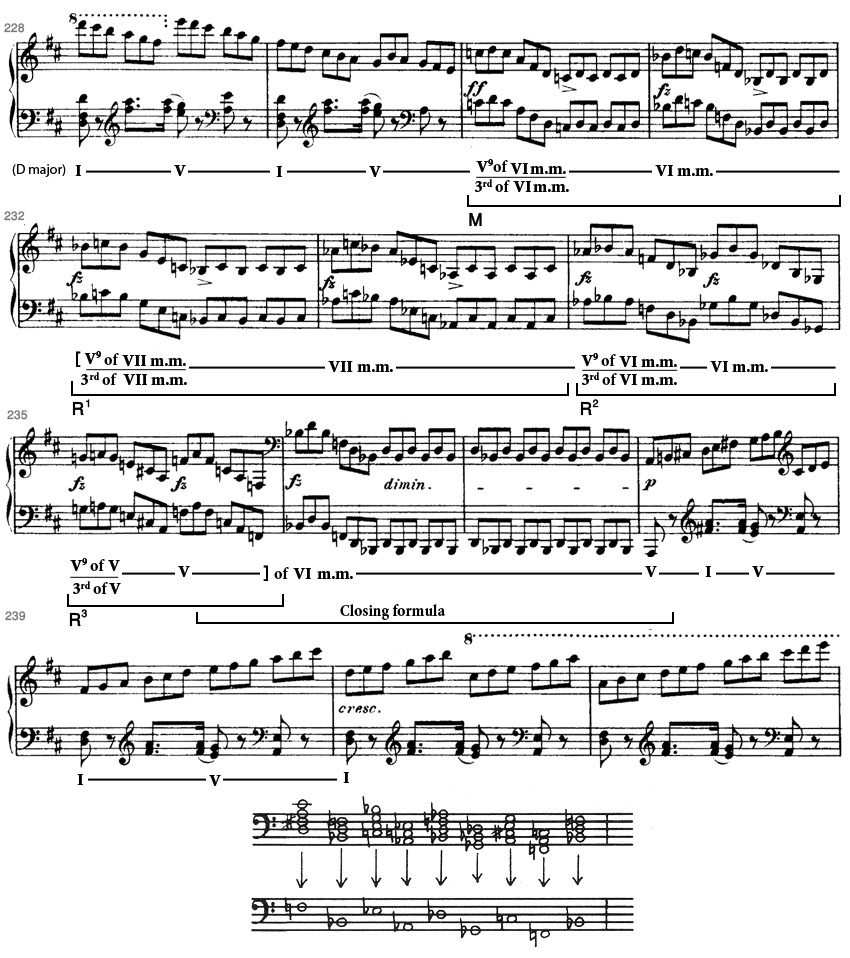
The
last couple could, of course, result from a deceptive cadence gesture
(V-III), but sometimes study of the context incites a search for
another meaning. An attentive examination of this entire first
movement and in particular of measures 10-16 and 263-265 supports
the interpretation given above. In fact, measures 11 to 16 present a
circle of fifths progressing by descending major thirds in the bass
(a progression which consequently becomes quickly saturated) with a
series of V9/3rd of I - I pairs, and this occurs very boldly in the
context of the exposition of the first theme group:
Example 459 : F. Schubert : Piano sonata, op. 53, D. 850, I (mm 10-16)
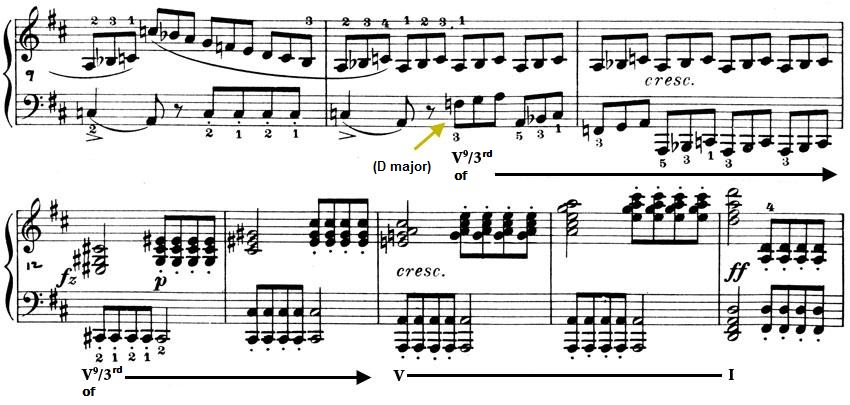

We find the same progression once again at the end of this first movement (measures 263-277):
Example 460 : F. Schubert : Piano sonata, op. 53, D. 850, I (mm 261-267)
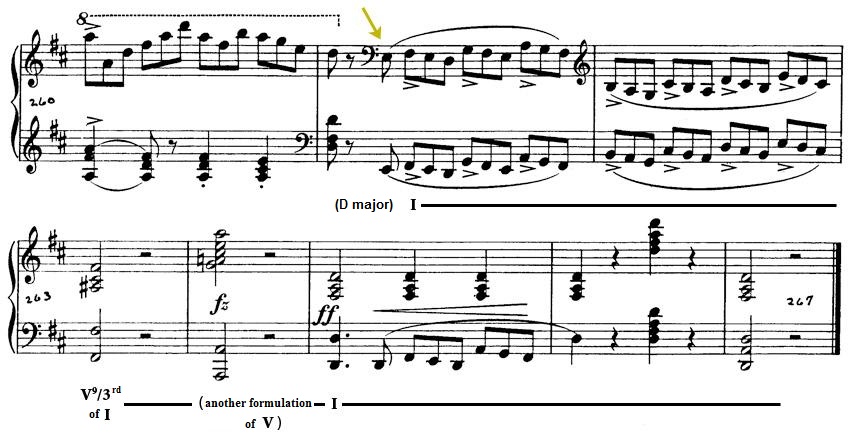
Likewise,
in an excerpt from another sonata by Schubert, we find a passage
where the orthography of the same pair corroborates this analytical perspective:
Example 461 : F. Schubert : Piano sonata, op. 143, D. 784, II (mm 35-38)
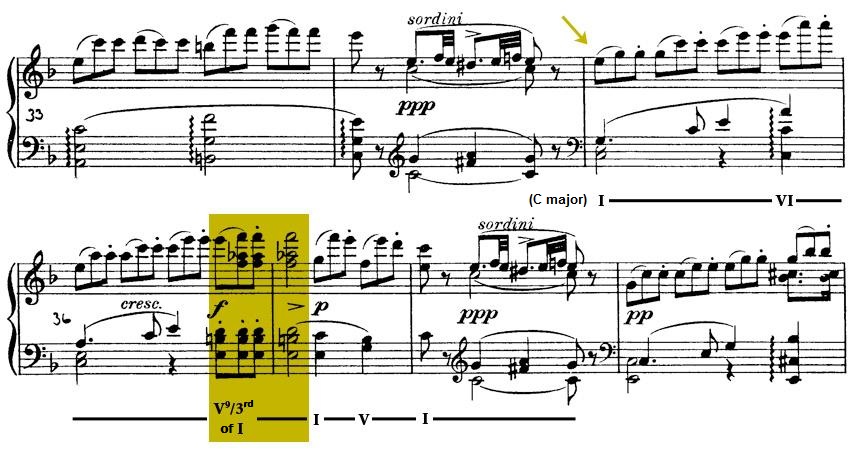
Example 462 : F. Liszt : Concert etude no 3, in Db major (end)
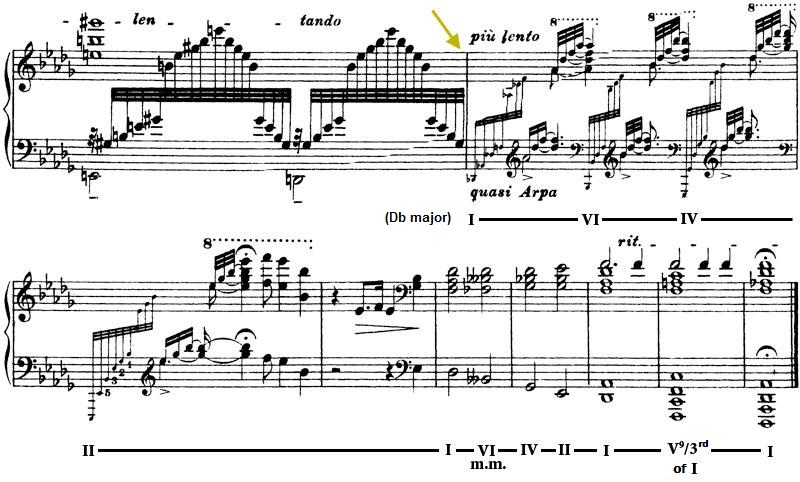
Second bizarre couple:
Figure 44
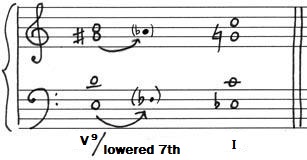
In
this second case, the function V is obtained through recourse to a
diminished seventh structure, or, more precisely, to a dominant minor ninth
chord without the root, where the seventh is altered,
lowered by a semitone.

Example 463 : F. Chopin : Etude, op. 25, no 11 (mm 49-54)
a) Type 8 sequence and b) type 1 sequence

The
preceding passage contains the only gesture at odds with the
otherwise very orthodox harmonic discourse of the etudes by Chopin,
including Opus 10, Opus 25, and the three posthumous etudes (the
challenge is elsewhere!). Transcending time, this gesture seems to
recall the remarkable and singular opening of Moro lasso by Gesualdo which juxtaposes both of these bizarre pairs (daring this anachronistic analysis):
Example 464 : C. Gesualdo : Moro lasso, Madrigal in 5 voices, book VI, W.6/74 (mm 1-6)
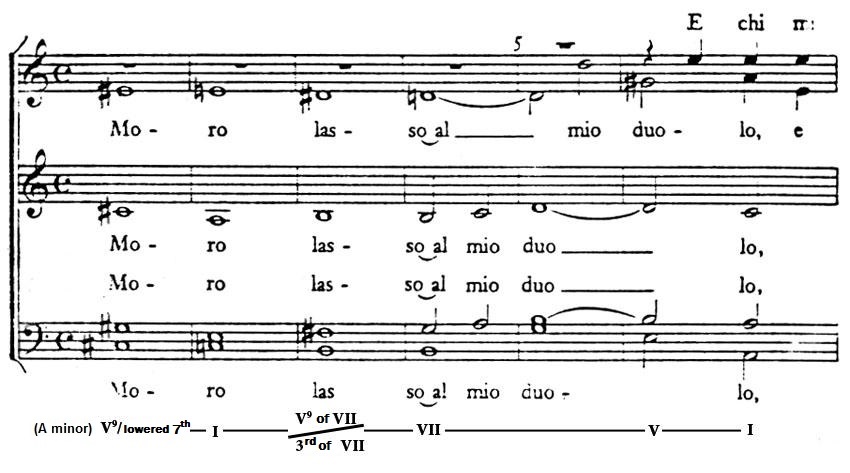
Again in Chopin's work, we find this pair of V9 on the lowered seventh - I in:
Example 465 : F. Chopin : Nocturne, op. 37, no 2 (mm 79-84)
Type 1 sequence with V9/lowered 7th

and then from Bruckner, in:
Example 466 : A. Bruckner : Motet Graduel Locus Iste (mm 21-29)
Type 1 sequence with V9/lowered 7th
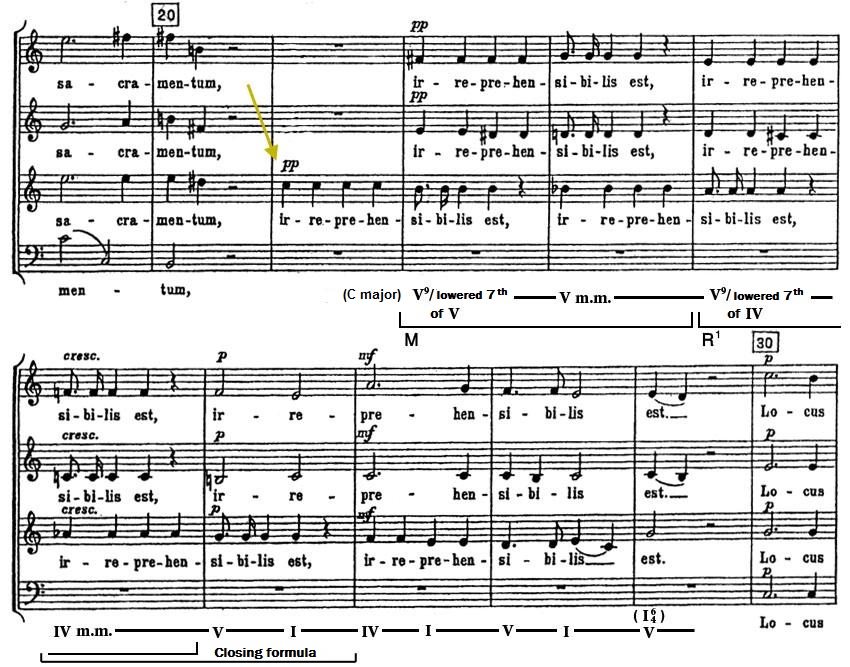
5. Irregularities in opening a work
It is
once again the harmonic sequence which permits, very insidiously,
to break with the tradition of how to open a work:
Example 467 : L.V. Beethoven : Piano sonata no 21, op. 53 (mm 1-13)
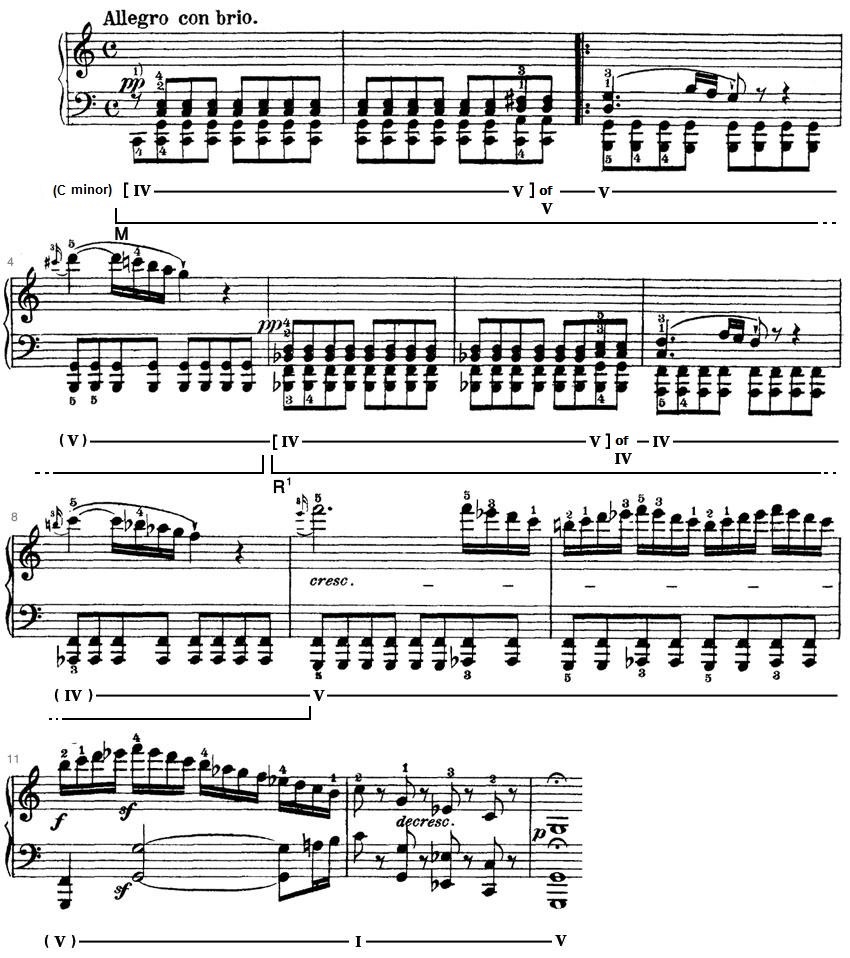
It
seems acceptable here that the work begins with a tonic chord with
respect to
the principal tonic (C major). However, if we listen closely, if we
look
closely, according the axis of symmetry suggested by the composition, we
realize that in fact we are dealing with a sub-dominant chord in the formula
(IV-V-I) which is treated sequentially. It must be added, though, that
the tonic function of
the first chord is not necessarily irrelevant and it is opportunely
restored in the
re-exposition. This perspective clarifies the role played by the
B flat major chord in measure 5. The same phenomenon is repeated in the
following example:
Example 468 : F.Mendelssohn : Variations sérieuses, op. 54 (mm 1-4)
a) Formula in sequence (IV-V) and b) type 4 sequence
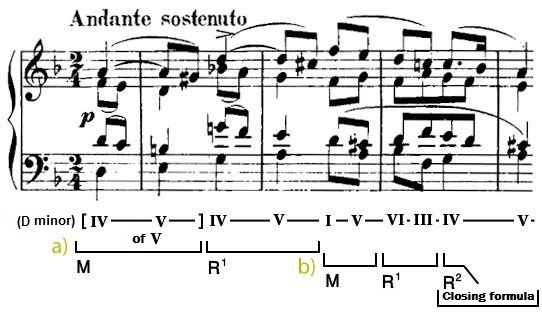
The
same type of analysis applies here. The first chord (D minor),
corresponding to the tonic of the principal key, will first be heard as
the sub-dominant of the dominant in the formula (IV-V) which is treated in sequence.
9. Conclusion  |
